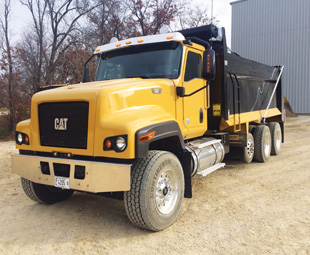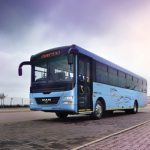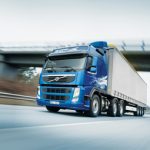First new International truck branding emerges

In his monthly review of global news for local truckers, FRANK BEETON details the first re-designated International truck family for North America, notes what appears to be the sad end to the Caterpillar truck story, looks at a whole slew of new Indian trucks, and gives a brief account of an interesting new product range from Mahindra and Mahindra
At the end of last year, we reported on Navistar International’s plans to rebrand its entire North American truck line-up. This would involve the deletion of the TranStar, PayStar, ProStar, WorkStar, TerraStar and DuraStar nameplates, and their replacement by an alphanumeric designation system consisting of two letters, followed by three numbers. The numeric code would indicate whether the model has a long or short bonnet and the forward or rearward positioning of its front axle.
During February, details of the HX Series vocational truck family were announced. It is described by the manufacturer as a “severe service, premium vocational truck”, and is intended to replace the erstwhile PayStar range.
 The line-up consists of: the HX515 short bonnet, set-forward axle rigid truck chassis; the HX520 long bonnet, set-forward axle rigid or truck-tractor chassis; the HX615 short bonnet, set-back axle, rigid, or truck-tractor chassis; and the HX620 long bonnet, set-forward axle, rigid or truck-tractor chassis.
The line-up consists of: the HX515 short bonnet, set-forward axle rigid truck chassis; the HX520 long bonnet, set-forward axle rigid or truck-tractor chassis; the HX615 short bonnet, set-back axle, rigid, or truck-tractor chassis; and the HX620 long bonnet, set-forward axle, rigid or truck-tractor chassis.
Applications, or “vocations”, covered by this range include truck mixer, construction dumper, roll-on/roll-off, crane truck, platform stake/crane and heavy-haul truck-tractor.
Power choices
The HX515 and HX615 models are powered by Navistar’s in-house, 13-litre N13 engines, while the HX520 and HX620 models are equipped with Cummins 15-litre ISX15 diesels. Interestingly, Navistar has re-designated its erstwhile MaxxForce 13 engine as the N13, following the introduction of selective catalytic reduction emissions countermeasures in 2013.
The basic design of this six-cylinder, in-line engine dates back to the 2004 strategic component manufacturing alliance between Navistar and Germany’s MAN Nutzfahrzeuge AG. Regular readers will be aware of the difficulties that confronted Navistar over the non-compliance of some of its power units with the EPA 2010 emission standards currently in force for vehicles being sold in the United States.
This was resolved in 2013 by a two-pronged strategy that included a definitive, long-term supply agreement with engine specialist manufacturer Cummins Inc, for the provision of both engines and emissions after-treatment technologies, the latter of which would be applied to Navistar’s own range of heavy-duty big-bore engines, including the N13.
Other HX features
Transmission options for the HX range include the Eaton 8LL 18-speed manual, Eaton Ultrashift automated mechanical, or Allison 4 000, 4 500 or 4 700 Series fully automatic gearboxes.
Other HX Series product features include huck-bolted chassis frames and cross members, an aluminium cab with ergonomically designed interior, three-piece Metton bonnet assembly [Metton Liquid Moulding Resin is a tough and durable engineering plastic material used to produce large or thick moulded parts for diversified applications, including, in this case, vehicle bonnets], stainless steel piano-door hinges and an extra-heavy-duty tow pin for extreme recovery towing.
The 40o front wheel cut angle on both sides enables improved manoeuvrability, while the cab suspension incorporates 52-inch springs to improve comfort and reduce noise. Standard equipment includes LED lighting, air-conditioning, power windows and power door locks.
The HX Series order book was opened in February for deliveries in March/April. This range is to be followed by the LT Series, which will replace the current ProStar family, later in the year.
CATERPILLAR BOWS OUT OF ON-HIGHWAY TRUCKING
It was only in the November issue of FOCUS that we carried news of Caterpillar Inc.’s intention to take over the manufacture of its own-branded vocational trucks for the North American market from Navistar International, and build these products in its Victoria, Texas excavator-manufacturing plant.
The announcement intimated that Victoria was to become the future design and engineering centre for Caterpillar’s range of dumper, mixer and haulage trucks, to carry on from the CT660, CT680 and CT681 models, which, earlier, had been sourced through the erstwhile NC² collaboration with Navistar International.
This certainly suggested that Caterpillar was serious about persevering in this specialist area of the truck market, despite the earlier dissolution of the NC² joint venture between the iconic yellow-metal specialist and Navistar International that ran from 2009 to September 2011.
 That cooperation had promised so much at a time when Navistar seemed intent on establishing a broader global footprint for itself in the trucking business through a number of multi-national joint ventures.
That cooperation had promised so much at a time when Navistar seemed intent on establishing a broader global footprint for itself in the trucking business through a number of multi-national joint ventures.
However, problems emanating from the non-compliance of some of International’s MaxxForce engines to the EPA 2010 emissions regime (see reference in previous article) precipitated a period of consolidation at Navistar, and subsequent abandonment of much of its globalisation strategy.
An astonishing announcement!
Nevertheless, Caterpillar seemed determined to forge ahead with its North American truck business, and “Cat” branding continued to be applied to a series of International-built heavy-duty truck tractors for the Australian market.
However, on February 26, Caterpillar announced that it was to discontinue production of on-highway vocational trucks, and withdraw from this market!
Apparently this decision was based on a reading of the prevalent business climate, and was said to be consistent with the company’s ongoing restructuring activities “to align its businesses with existing conditions”.
 To say we were astonished by this announcement would be a major understatement. The number of radical direction changes that have been taken by Caterpillar, with regard to its relationship with the truck market since the 2009 announcement of the NC² joint venture, are hardly consistent with the execution of a well-thought-out strategy. It is a well-known fact that the truck industry does not like indecision, and that operators/buyers prefer to do business with suppliers who are in it “for the long haul”.
To say we were astonished by this announcement would be a major understatement. The number of radical direction changes that have been taken by Caterpillar, with regard to its relationship with the truck market since the 2009 announcement of the NC² joint venture, are hardly consistent with the execution of a well-thought-out strategy. It is a well-known fact that the truck industry does not like indecision, and that operators/buyers prefer to do business with suppliers who are in it “for the long haul”.
Caterpillar’s mainstream business in construction equipment is even more cash-intensive than trucking, so one would imagine that consistency of strategic direction is equally important in that field.
Erosion of credibility
Back in 2008, when the first news of the NC² partnership broke, Caterpillar also announced that it would no longer supply its highly successful proprietary engines to specialist truck builders, but would jointly develop engine platforms with Navistar.
Up to then, Caterpillar’s ACERT series of diesel engines had established a loyal following in truck markets across many parts of the world. This decision left customers, who had adopted Caterpillar as their engine supplier of choice, with no option but to make alternative arrangements.
Given its recent history, it is perhaps wise that Caterpillar has decided to disengage completely from the truck market where its potential to win back customer confidence would have been eroded by this recent series of events.
We are not aware, at time of writing, if any further decision has been taken with regard to the continuation of Caterpillar branding on trucks marketed in Australia, but we would expect that Navistar’s efforts in that market will be concentrated entirely on International brand products going forward.
LOTS OF NEW TRUCKS FOR THE INDIAN MARKET
In recent times, India has become an increasingly important source of truck products for export to markets with less demanding emissions regimes, such as the Euro-2 standard currently applicable in South Africa. This has potentially increased interest in product developments in that country to readers of Global Focus.
As we have pointed out previously, Indian buying preferences are materially different to those in this country, particularly in respect of engine power outputs when related to gross vehicle and combination masses. This is, presumably, a reflection of differing traffic average and maximum speeds.
Nevertheless, it is a worthwhile exercise to keep track of new Indian-sourced products, as variants of these may well find their way to our local market in the months and years ahead
The EXCON India construction equipment trade fair, held in Bangalore late last year, and the Auto Expo 2016, staged in New Delhi in February, saw a slew of new products launched by truck manufacturers active in the Indian market.
Understandably, most of the new products exhibited at EXCON were targeted at the construction industry, which primarily utilises tippers, truck mixers, crane trucks and concrete pumpers, while those displayed at the later show were of interest to a broader market. The following details, listed by manufacturer, describe some of the more interesting exhibits at the two shows.
Tata Motors
• Tata Prima 3138.K. Described as a 8×4 heavy-duty tipper intended for coal mining applications, the 3138.K is powered by a 285 kW (380 hp), 8,9-litre Cummins ISLe engine, driving through an Eaton ES-150409 nine-speed manual or Allison fully automatic transmission to a 48-t capacity planetary hub-reduction rear bogie.
• Tata Prima LX 3128.K. Yet another 8×4 tipper chassis, the LX 3128.K is intended for high-density opencast mining applications, and is powered by a 210 kW (280 hp) 6,7-litre Cummins ISBe CRDI engine, driving through Tata’s own nine-speed G1150-DD gearbox with crawler gear, to a 48-t capacity RA 109 rear bogie.
• Tata Prima LX 2523.K Re PTO. A dedicated three-axle truck mixer chassis with standard engine-driven power take-off. Powered by a 170 kW (230 hp) 6,7-litre Cummins ISBe engine coupled to the same gearbox as the LX 3128.K and driving through a RA 109 single-reduction rear bogie.
• Tata SAK 1613 4×4. A new all-wheel-drive, 16-t gross vehicle mass (GVM) truck chassis fitted with a 97 kW (130 hp) Cummins B59 turbocharged engine, driving through Tata’s own six-speed G600-DD gearbox and TC 2500 auxiliary gearbox to single-reduction front- and rear-drive axles.
• The Tata Signa series. These sub-premium medium and heavy trucks, which replace the legacy non-Prima line-up, will feature a new improved and upgraded version of the familiar Tata cab (which had its roots in a mid-1970s Mercedes-Benz design), to which a one-piece windscreen and more stylish grille has been added.
It is equipped with suspension seats and features improved safety, reduced noise, vibration and harshness levels, as well as improved ventilation and visibility. The first three models to be launched were the Signa 4923.S truck tractor, Signa 2518.K three-axle tipper chassis and the Signa 3118.T twin-steer 8×2 truck with lifting or steering rearmost axle.
The 4923.S is powered by a 170 kW (227 hp) Cummins ISBe 5,9-litre engine, while the 2518.K and 3118.T are fitted with 135 kW (180 hp) Tata Cummins B5.9 L-6 power units. Both the 4923.S and 2518.K employ Tata’s G1150 nine-speed transmission, while the 3118.T utilises the Tata G750 six-speed unit.
Volvo Eicher Commercial Vehicles (VECV)
• VECV PRO 8000 Series 8031XM. The PRO 8000 series has a close visual resemblance to UD’s Quester range, but specifications and frontal styling have been fine-tuned to meet Indian market preferences.
 The 8031XM is a new 8×4 tipper chassis, powered by the 7,7-litre Volvo VEDX8 diesel engine developing
The 8031XM is a new 8×4 tipper chassis, powered by the 7,7-litre Volvo VEDX8 diesel engine developing
245 kW (330 hp), driving through VECV’s nine-speed manual transmission to a pair of hub-reduction rear-drive axles. This unit is intended to be fitted with either an 18/20 m³ conventional tip, or 16/18m³ rock dumper body.
• VECV PRO 8000 Series 8049HD 49-t GCW truck tractor. This heavy-duty unit is available with both 6×4 and 6×2 drive configurations. It is powered by the 210 kW (280 hp) output version of Volvo’s VEDX8 diesel, driving through a nine-speed, direct-top-ratio gearbox. The 6×2 variant has a single-reduction drive axle, while the 6×4 model offers a choice of single- or hub-reduction bogies.
Daimler India Commercial Vehicles (BharatBenz)
• An updated version of the 3143 Thunder Bolt rigid tipper, powered by the 12-litre Mercedes-Benz OM457 six-cylinder diesel developing 315 kW (430 hp), driving through an automated 12-speed transmission, suitable for fitment of a 19,5 m³ rock dumper or 32 m³ coal carrier bodies.
Pune MAN Trucks India
 • The new 31.280 8×2 haulage truck and 49.300 6×4 truck-tractor models were displayed by the wholly MAN-owned successor to the previous joint venture with Force Motors. The former 210 kW (280 hp) model is targeted at the construction industry, while the latter 49 t gross combination mass (GCM) 225 kW (300 hp) unit is intended for the transportation of construction equipment which exceeds normal dimensional limitations.
• The new 31.280 8×2 haulage truck and 49.300 6×4 truck-tractor models were displayed by the wholly MAN-owned successor to the previous joint venture with Force Motors. The former 210 kW (280 hp) model is targeted at the construction industry, while the latter 49 t gross combination mass (GCM) 225 kW (300 hp) unit is intended for the transportation of construction equipment which exceeds normal dimensional limitations.
Ashok Leyland Limited
• The first Euro-6, 49-t GCM truck tractor from India’s second-largest truck manufacturer (after Tata Motors), was displayed. Designated 4940 it is powered by an in-house Neptune six-cylinder engine.
• An intriguing new cruiserweight model branded GURU was also on display. This 12-t GVM unit is reportedly derived from AL’s joint venture with Nissan Motors, which up to now has produced an indigenised version of Nissan’s Cabstar light truck, which is also sold with Ashok Leyland branding in India, rated at 6 600/6 700 kg GVM. However the GURU is reportedly powered by a 90 kW (120 hp) three-cylinder Hino CRS engine, which, together with its 12-t GVM rating, makes the reported Nissan link somewhat difficult to fathom!
… AND WE DISCOVER THE MAHINDRA and MAHINDRA BLAZO!
Back in 2011, the South African Navistar International operation displayed long and short versions of a truck cab at the Johannesburg International Motor Show, which was said to herald the imminent arrival of a new product series named “MetroStar”.
At that time, the American manufacturer was short of the forward-control models it needed to take a greater share of the local truck market, particularly in the heavy commercial vehicle, and lower reaches of the extra-heavy commercial vehicle segments. The evidence suggested that it had found a convenient solution in a range of products being developed by its Indian truck and engine-building joint ventures with Mahindra and Mahindra.
However, Navistar subsequently sold its shares in those joint ventures to Mahindra and Mahindra, leaving the Indian company to carry on independently. We have reported previously on Mahindra and Mahindra’s unilateral plans to develop and expand the range, but the announcement, during February, of the new Blazo “smart truck range”, has encouraged us to update the story of the Indian concern’s continuing efforts in the truck market.
Blazo Positioning
At the launch stage, the Blazo range is still concentrated in the GVM/GCM spectrum between 25 and 49 t, which means that the long-promised lighter models between 9 and 16 t GVM are still in the future, although the company says they will appear over the next two years.
The cab design is still recognisably the one we first saw in 2011, while the standard power unit, covering the output range from 165 to 205 kW (220 to 274 hp), is an Indian-manufactured version of Navistar’s MaxxForce six-cylinder 7,2-litre engine.
The Blazo catalogue includes two, three, four and five-axle models, which can be described as “typically Indian” in terms of the offered features and options, although it is quite surprising to see that the range includes a chassis/cowl option that caters for aftermarket cab construction by specialist coachbuilders.
The main Blazo selling feature appears to be its three-mode “FuelSmart” system which allows
the driver to select the most appropriate power setting for the prevailing payload and operating conditions.
In our continued pondering over the fate of Navistar International in South Africa, we cannot help wondering if there may still be a future for these Mahindra and Mahindra products, or maybe just its forward control cab, in that scenario. What we are sure of, however, is that the longer such a decision is put off, the more difficult it will be for Navistar to re-establish a presence in the local truck market.
Global FOCUS is a monthly update of international news relating to the commercial vehicle industry. It is compiled exclusively for FOCUS by Frank Beeton of Econometrix.
Published by
Focus on Transport
focusmagsa




